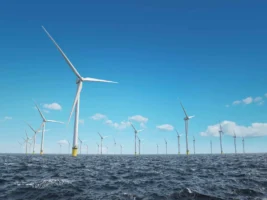We constantly hear that the future of electricity will be distributed and democratised, thanks to the new suite of technologies such as rooftop solar, battery storage, demand management and electric vehicles that literally delivers power and controls into the hands of consumers.
But what exactly does this look like in a world that is now based around centralised generation, a hub and spoke network of poles and wires, with talk of yet more large transmission links? And how does the transition take place given the huge sums of money already invested in the status quo?
To get the clearest answer, you need to look west, to the state of Western Australia where the state-owned network operator Western Power has given its latest vision of what the future network looks like.
Like all network operators in Australia, Western Power understands that it is far cheaper, safer and cleaner to serve many remote and regional customers with systems built around solar and battery storage, rather than relying on the costly lengths of poles and wires vulnerable to bushfires, lightning, strong winds, salt and any number of mishaps.
It is why the market rule-maker finally agreed this year on new rules that would remove barriers and give network owners regulatory permission, and a financial incentive, to cut down those poles and wires and replace them with stand alone power systems, or renewable micro-grids.
But only Western Power has thought deeply enough about the issue to talk publicly about what this might look like. And the result is a complete turnaround from we normally expect of a public network.
Its regional sister, Horizon Power, which operates the vast expanse of regional W.A., is taking 17 customers off an isolated grid near Esperance and fitting them out with stand alone systems based around solar and batteries, becoming the first utility to formally take down poles and wires (64kms) and replace them with local systems.
Western Power has been doing its own trials with six customers over the last two years, and found that on average the customers sources 91 per cent of their electricity from solar panels, and they avoided an 90 hours of power outages per year.
That’s cheaper and more reliable. It is now preparing a trial of another 60 customers, spread across its grid.
But that’s just a fraction of what may happen.
According to Western Power, it might make sense for some 15,000 customers to be taken off the grid and given their own power system. Another 100 communities could have micro-grids to serve their needs.
That will likely amount to thousands of kilometres of power lines that are removed. (There are 918,000kms of poles and wires in the country). And Western Power notes that half of its network costs go to serve just 3 per cent of its customer base.
Western Power first gave some insight into why it saw its future as a modular network a few years ago, when it outlined why it made sense to cut some communities off from the grid entirely, and provide only a “thin” line to others who would be largely, but not completely independent.

Now it’s taken the idea a step further, describing the split between “autonomous” customers and those within its “mesh”, many of them served by community-scale batteries, which the utility is already trialling. And Western Power is also keen to take many of its poles and wires underground.
This graph above is fascinating – it portrays the heavily populated part of the South West Integrated System, the main grid in W.A. Western Power sees transmission and poles and wires (in green) continuing to provide links, but vast swathes (in orange) are disconnected and act autonomously. Some are quite close to Perth.
Western Power has long argued that encouraging micro-grids – be they autonomous, connected, or in the form of individual stand alone power systems for individual homes and businesses – is essential to maintain and improve reliability and security.
The micro-grids protect those consumers from faults elsewhere in the network, and reduces costs significantly – both because of reduced spending on costly poles and wires, and also because of the cheaper options on site in the form of renewables, be they solar or wind, and storage and other technologies.
It has argued that they are safer, and they can accommodate the “green town” vision of many communities that want to integrate renewables into their local power needs. And it will stimulate regional growth.
In a recent blog post on the Western Power website titled “Beer and batteries”, the company’s head of strategy Peter Kerr compares the emergence of distributed resources such as rooftop solar and battery storage to that of craft brewers, and described the utility’s response.
“Over the past couple of years, we’ve been trialling a bunch of different solutions and products. It’s exciting stuff, and it’s showed us is that the future of our grid will really be a tale of two networks,” Kerr writes.
Much of the grid will be more autonomous, using stand-alone power systems and microgrids to create their own power, often renewably. “This is a win for them – and for us. Their reliance on the grid is reduced, which means they have fewer outages, and we have less costly upgrades of infrastructure that only services a very small number of people.”
The others will remain part of the “mesh” network. And here, Kerr and Western Power are underlying the importance of staying on the grid and avoiding defections. One of their principal tools in helping this is the development of “community” battery banks, such as in Mandurah, that allows customers to store their excess solar output in a local battery, and draw on it when they need.
Kerr says the network was stunned when a new school in Two Rocks, about 60km north of Perth, chose to spend its money on solar and batteries rather than the cost of a new connection.
“That in itself is not a bad thing, but in doing so we lost a contributor to keeping the grid functioning,” Kerr notes.
“We need to change the perception that going off grid is actually the right thing to do … by offering products and services that let our customers source, store, use and manage their power the way they want to. On the grid. And by keeping grid power affordable, safe and reliable.”
That, one presumes, will lead to some interesting conversations about connection costs. But at least Western Power is trying.
Most networks in the eastern states have got as far as thinking about cutting off some of their most remote customers, but we can’t see any evidence – apart from isolated trials at Yackandandah in Victoria – of a major re-think on what the grid of the future looks like.










